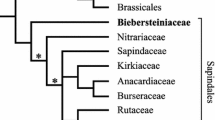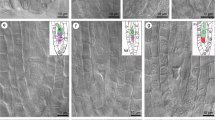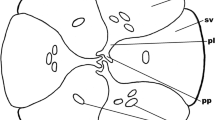Abstract
Austrobaileyales, comprising the four families Austrobaileyaceae, Trimeniaceae, Schisandraceae, and Illiciaceae, are included in the basal angiosperms along with Amborellaceae and Nymphaeaceae. Here, we present the first developmental study of the female gametophyte in Austrobaileya scandens, the only species of Austrobaileyaceae, which are sister to the rest of the Austrobaileyales. Austrobaileya scandens has a four-celled/four-nucleate embryo sac as in the derived families of the order, e.g., Illiciaceae and Schisandraceae. It is monosporic, with the chalazal megaspore of a tetrad developing into the embryo sac composed of an egg cell, two synergids, and one polar nucleus. This mode of embryo sac formation was first reported in Schisandra over 40 years ago and should now be established as the Schisandra type. Its occurrence in A. scandens shows that the Schisandra-type embryo sac is likely common to the whole Austrobaileyales as well as to Nymphaeaceae. Amborellaceae were recently reported to have an eight-celled/nine-nucleate embryo sac, clarifying that none of the basal angiosperms has the seven-celled/eight-nucleate Polygonum-type embryo sac found in the majority of angiosperms, and that the Polygonum-type embryo sac represents a derived character state in angiosperms.




Similar content being viewed by others
References
Battaglia E (1986) Embryological questions: 7. Do new types of embryo sac occur in Schisandra? Ann Bot 44:69–82
Batygina TB, Vasilyeva VE (2002) Oenothera-type embryo sac development. In: Batygina TB (ed) Embryology of flowering plants. Terminology and concepts 1. Science Publishers, Enfield, pp 173–177
Batygina B, Shamrov II, Kolesova GE (1982) Embryology of the Nymphaeales and Nelumbonales II. The development of the female embryonic structures (in Russian). Bot Zh 67:1179–1195
Borsch T, Hilu KW, Quandt D, Wilde V, Neinhuis C, Barthlott W (2003) Noncoding plastid trnT-trnF sequences reveal a well resolved phylogeny of basal angiosperms. J Evol Biol 16:558–576
Davis GL (1966) Systematic embryology of flowering plants. Wiley, New York
Endress PK (1980) The reproductive structures and systematic position of the Austrobaileyaceae. Bot Jahrb Syst 101:393–433
Friedman WE (2006) Embryological evidence for developmental lability during early angiosperm evolution. Nature 441:337–340
Friedman WE, Williams JH (2003) Modularity of the angiosperm female gametophyte and its bearing on the early evolution of endosperm in flowering plants. Evolution 57:216–230
Friedman WE, Gallup WN, Williams JH (2003) Female gametophyte development in Kadsura: implications for Schisandraceae, Austrobaileyales, and the early evolution of flowering plants. Int J Plant Sci 164(Suppl 5):S293–S305
Galati BG (1985) Estudio embriologicos en Cabomba australis (Nymphaeaceae) I. La esporogenesis y las generaciones sexuadas. Bol Soc Argent Bot 24:29–47
Hayashi Y (1963) The embryology of the family Magnoliace ae sens. lat. II. Megasporogenesis, female gametophyte and embryogeny of Schisandra repanda Radlkofer and Kadsura japonica Dunal. Sci Rep Tôhoku Univ Ser IV (Biol) 29:403–411
Igersheim A, Endress PK (1997) Gynoecium diversity and systematics of the Magnoliales and winteroids. Bot J Linn Soc 124:213–271
Johri BM, Ambegaokar KB, Srivastava PS (1992) Comparative embryology of angiosperms, vols. 1, 2. Springer, Berlin
Judd WS, Campbell CS, Kellog EA, Stevens PF, Donophue MJ (2002) Plant systematics. A phylogenetic approach, 2nd edn. Sinauer Associates, Sunderland
Kapil RN, Jalan S (1964) Schisandra: its embryology and systematic position. Bot Notiser 1964:285–306
Kimoto Y, Tobe H (2003) Embryology of Siparunaceae (Laurales): characteristics and character evolution. J Plant Res 116:281–294
Maheshwari P (1950) An introduction to the embryology of angiosperms. McGraw-Hill, New York
Orban I, Bouharmont J (1998) Megagametophyte development of Nymphaea nouchali Burm. f. (Nymphaeaceae). Bot J Linn Soc 126:339–348
Qiu YL, Lee J, Bemasconi OF, Soltis DE, Soltis PS, Zanis M, Zimmer EA, Chen Z, Savolainen V, Chase MW (1999) The earliest angiosperms: evidence from mitochondrial, plastid and nuclear genome. Nature 402:404–407
Qiu YL, Dombrovska O, Lee J, Li L, Whitlock BA, Bernasconi-Quadroni F, Rest JS, Davis CC, Borsch T, Hilu KW, Renner SS, Soltis DE, Soltis PS, Zanis MJ, Cannone JJ, Gutell RR, Powell M, Savolainen V, Chatrou LW, Chase MW (2005) Phylogenetic analyses of basal angiosperms based on nine plastid, mitochondrial, and nuclear genes. Int J Plant Sci 166:815–842
Soltis PS, Soltis DE (2004) The origin and diversification of angiosperms. Am J Bot 91:1614–1626
Soltis DE, Soltis PS, Endress PK, Chase MW (2005) Phylogeny and evolution of angiosperms. Sinauer Associates, Sunderland
Swamy BGL (1964) Macrogametophytic ontogeny in Schisandra chinensis. J Indian Bot Soc 43:391–396
Takhtajan A (1991) Evolutionary trends in flowering plants. Columbia University Press, New York
Tobe H, Raven PH (1983) An embryological analysis of myrtales: its definition and characteristics. Ann Mo Bot Gard 70:71–94
Tobe H, Raven PH (1996) Embryology of Onagraceae (Myrtales): characteristics, variation and relationships. Telopea 8:667–688
Tobe H, Jaffré T, Raven PH (2000) Embryology of Amborella trichopoda (Amborellaceae): descriptions and polarity of character states. J Plant Res 113:271–280
van Miegroet F, Dujardin M (1992) Cytologie et histologie de la reproduction chez le Nymphaea heudelottii. Can J Bot 70:1991–1996
Willemse MTM, van Went JL (1984) The female gametophyte. In: Johri BM (ed) Embryology of angiosperms. Springer, Berlin, pp 159–196
Williams JH, Friedman WE (2002) Identification of diploid endosperm in an early angiosperm lineage. Nature 415:522–525
Williams JH, Friedman WE (2004) The four-celled female gametophyte of Illicium (Illiciaceae; Austrobaileyales): implications for understanding the origin and early evolution of monocots, eumagnoliids, and eudicots. Am J Bot 91:332–351
Winter AN, Shamrov II (1991a) Development of the ovule and embryo sac in Nuphar lutea (Nymphaeaceae) (in Russian). Bot Z 76:378–390
Winter AN, Shamrov II (1991b) Megasporogenesis and embryo sac development in representatives of the genera Nymphaea and Victoria (Nymphaeaceae) (in Russian). Bot Z 76:1716–1728
Yoshida O (1962) Embryogische Studien über Schisandra chinensis. J Coll Arts Sci Univ Chiba 4:459–462
Zanis MJ, Soltis DE, Soltis PS, Mathews S, Donoghue MJ (2002) The root of the angiosperms revisited. Proc Natl Acad Sci USA 99:6848–6853
Acknowledgments
This study was supported by a Grant-in-Aid for Scientific Research from the Japan Society for the Promotion of Science (No. 18370036) and a grant for Biodiversity Research of the twenty-first century COE (A14).
Author information
Authors and Affiliations
Corresponding author
Rights and permissions
About this article
Cite this article
Tobe, H., Kimoto, Y. & Prakash, N. Development and structure of the female gametophyte in Austrobaileya scandens (Austrobaileyaceae). J Plant Res 120, 431–436 (2007). https://doi.org/10.1007/s10265-007-0085-0
Received:
Accepted:
Published:
Issue Date:
DOI: https://doi.org/10.1007/s10265-007-0085-0




